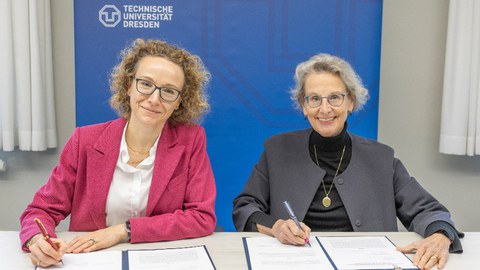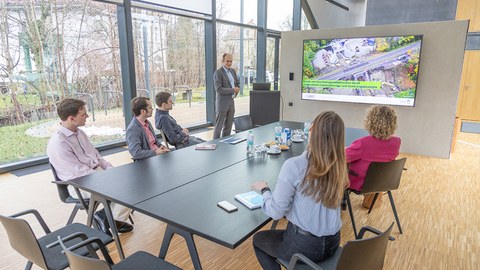Jan 16, 2025
Deutsche Bahn InfraGO and TU Dresden sign continuation agreement for DB InfraGO Endowed Chair at TUD

TUD Rector Prof. Ursula Staudinger (right) and Heike Junge-Latz, Head of Plant and Maintenance Management at DB InfraGO, sign the continuation agreement for the DB InfraGO Endowed Chair of Civil Engineering
Full speed ahead for the future of railroad construction in Germany: On January 15, 2025, TUD Dresden University of Technology (TUD) Rector Prof. Ursula M. Staudinger and Heike Junge-Latz, Head of Plant and Maintenance Management at DB InfraGO, signed the continuation agreement for the DB InfraGO Endowed Chair of Civil Engineering. The aim of this cooperation is to raise research and teaching in the field of railway-specific bridge and civil engineering to a new level.
By signing the continuation agreement, TU Dresden is consolidating its position as a location for sustainable construction in the railroad system and the modernization of the German rail network.
Challenge: refurbishment and traffic turnaround - sustainable bridge and track systems
The Head of Asset and Maintenance Management at DB InfraGO, Heike Junge-Latz, emphasizes the current challenges in infrastructure management for the railways: "The outdated infrastructure, combined with the sharp increase in traffic volumes due to the traffic turnaround, is causing enormous strain. At the same time, almost the entire rail network needs to be fundamentally renovated."
The Rector of TU Dresden, Prof. Ursula Staudinger, underlines the importance of the cooperation: "An Endowed Chair with Deutsche Bahn builds on the long tradition of cooperation between TU Dresden and Deutsche Bahn. It combines basic and applied research with industrial impact."
Prof. Steffen Marx from the Institute of Concrete Structures (IMB) at TUD highlights the main focus of the research: "Our aim is to develop methods for the renovation of existing bridges and to significantly extend the service life of structures." In addition to vaulted bridges, steel, composite and reinforced concrete bridges will also be investigated in the future.
Important foundations laid - more durable roadway systems
The Chair was already able to achieve significant success in the first funding period by developing renovation strategies for arch bridges. Junge-Latz emphasizes: "The results are not only theoretically sound, but also practically applicable. They contribute to making bridges usable again for the next 50 years - a noticeable effect for the rail system in Germany."
According to Junge-Latz, another advantage of the collaboration with TU Dresden lies in the interdisciplinary research structure: "The bundling of diverse disciplines and the exchange between different specialist areas create valuable impulses and innovations that go beyond classic civil engineering."
An important success of the first funding period was the introduction of a holistic refurbishment concept. This makes it possible to avoid the construction of new replacements by refurbishing existing bridges. To this end, a framework agreement for structural diagnostics and a module for the railroad bridge construction regulation (guideline 804) were developed, which will be introduced as mandatory from May of this year.
A strong foundation for research and practice

Prof. Steffen Marx vom Institut für Massivbau stellt im Carbonbetonhaus CUBE Ergebnisse aus der ersten Förderperiode vor und gibt Einblicke in die Arbeit der Forschenden
For the second funding period, the focus is on railroad track systems. "Track systems cause the highest consumption of resources and CO₂ emissions," says Marx. The aim is to extend the service life of track systems through innovative approaches. "We are currently analyzing weak points in design and quality and are working with partners to develop sustainable solutions."
Background DB InfaGO Endowed Chair:
The DB InfraGO Endowed Chair illustrates how science and practice can work together to create forward-looking solutions for civil engineering and transport infrastructure - a milestone for the transport transition and the sustainable development of railroads in Germany.
